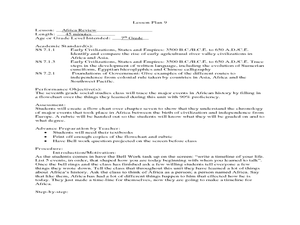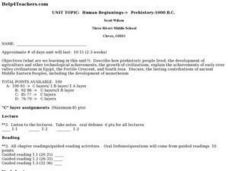Core Knowledge Foundation
Early Asian Civilizations Tell It Again!™ Read-Aloud Anthology
Eighteen lessons make a read-aloud anthology all about early Asian civilizations. Scholars listen to and discuss stories about the Indus River Valley, Hinduism, Silk, Buddhism, the Great Wall of China, Diwali, and more, alongside stories...
Core Knowledge Foundation
Early World Civilizations Tell It Again!™ Read-Aloud Anthology
Ancient world civilizations are the focus of a read-aloud anthology. First graders explore the early world of Mesopotamia, Babylon, the sphinx, and pyramids, get to know people of the Nile, Hatshepsut, and Tutankhamun, and examine world...
Curated OER
Writing Exercise: Neolithic Revolution and Early Civilizations
Use this handy worksheet after reading about the Neolithic Revolution. Learners can use this resource to compose three short answer questions regarding the transition from the Neolithic Revolution to early civilizations, what led to...
Curated OER
Empires of Early Africa
Ninth graders examine the Nile's role in the birth and growth of Egyptian civilization. In this World History lesson, 9th graders explore how archaeologists have learned about life in Ancient cities. Students present a report...
Curated OER
Early Humans
Eighth graders work together in groups to examine the earliest civilizations. After reading two stories, they compare and contrast the facts with those stories with other ones they have read. They discuss the different hypothesis on...
Curated OER
The Importance of Rivers in the Development of Early Civilizations Importance of Rivers in the Development of Early Civilizations
Sixth graders explore the role of rivers in the construction of early civilizations. In this importance of rivers lesson plan, 6th graders listen to a poem written by Langston Hughes and work cooperatively to develop a graphic organizer...
Curated OER
Elements of Civilization
Students create their own ancient civilizations based off of topographical maps of Egypt, Mesopotamia, the Indus Valley, and the Yellow River. In this social studies lesson, students are assigned one topographical map to use to create...
Curated OER
Four Ancient River Civilizations
Students explore how the environment shapes man, how man transformed his world, nd how art became part of the human process. The group is divided into clans and their migratory routes developed in the eight lessons of this unit.
Curated OER
Africa Review
Seventh graders trace the major events in African history. In this social studies lesson students, create a flowchart depicting the things they learned during this lesson. Students understand the chronology of major events that took...
Curated OER
Early Explorers
Fifth graders examine how the environment and climate affected Pre-Colombian settlements. In this civilization lesson, 5th graders view pictures of different Native American tribes in different places and discuss how different groups...
Curated OER
Mesopotamia: The Worksheet
Read to learn! Middle Schoolers read a short passage on Mesopotamia then answer seven comprehension questions. This would be ideal as homework or for early finishers.
Curated OER
Geography of Early China
Students research and identify the primary geographic features of China. They investigate which features isolated China, and identify the significance of the Hwang River to Early Chinese civilizations. Finally, they research the Silk...
Curated OER
Taking the Mystery Out of Mesopotamia
Students locate Mesopotamia on the map and explain the importance of its location. In this Mesopotamia lesson, students understand why the new discoveries of Mesopotamia were so important to civilization. Students participate in...
Weebly
Ancient China
From China's physical geography and earliest beginnings of civilization to the Qin and Han dynasties, here is a nicely designed worksheet on ancient China, which includes a graphic organizer and timeline to summarize the reading...
Curated OER
The Gifts of the Nile
Get your class thinking about the geography that shaped the Egyptian landscape and culture. They compare ancient climate zones and geogrpahical fetures, locate evidence of plate tectonics, take and quiz, and write a short essay. The...
Curated OER
Human Beginnings-> Prehistory-1000 B.C.
Middle schoolers describe how prehistoric people lived, the development of agriculture and other technological achievements, the growth of civilizations, explain the achievements of early river valley civilizations in Egypt, the Fertile...
Curated OER
Should the Ming End the Treasure Voyages?
During the first century of Chinese Ming dynasty (1368-1644), the government sent out a total of seven voyages into the Indian Ocean. Young historians will discuss, explain, role play, and compare the decisions made by rulers during the...
Curated OER
Ancient Egypt
For this Ancient Egypt worksheet, students read a 2 page article on Ancient Egypt, answer 3 statements as true or false and choose which multiple choice answers best answers 3 questions/statements.
Curated OER
Technology of the Ancient World Lesson Plans
Technology of the ancient world lesson plans can open students' eyes to the influence of early innovations.
Curated OER
Meso-America
Students will identify and locate Central and South America and their countries and features, as well as Meso-American civilizations. Students will compare civilizations and discuss voyages of relevant explorers.
Curated OER
China
Sixth graders become more aware of how land features, climate, and vegtation affect civilization. Students are divided into groups and research one of China's regions. They make a relief of their designated area.
Curated OER
Geography and World History
Students build off of their current knowledge of geography and world history, while being introduced to new concepts and ideas.
Curated OER
Wheat: Ancient and Ageless
Students label the parts of a wheat plant on a worksheet. In this Egyptian farming lesson, students thresh a wheat stem and estimate the amount harvested. Students research Ancient Egypt online.
Curated OER
D'Nile Is Where It's At!
Students travel down the Nile River to survey ancient Egypt in this unit of nine lessons. Data about pharaohs, hieroglyphics, growing crops, pyramids, the geography, and the sacred rituals are explored in this unit.

























